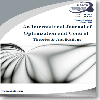An algorithm for solution of an interval valued EOQ model
An algorithm for solution of an interval valued EOQ model
___
- 1] Sengupta, A., Pal, T. K., On comparing interval numbers. European Journal of Operational Research, 127(1), 28-43 (2000).
- [2] Lin, D.C., Yao, J. S., Fuzzy economic production for production inventory. Fuzzy Sets and Systems, 111, 465-495 (2000).
- [3] Haris, F.W., How many parts to make at once. Factory, The Magazine of Management, 10(2), 135-152 (1913).
- [4] Mahata, G.C., Goswami, A., Fuzzy EOQ models for deteriorating items with stock dependent demand and non-linear holding costs. International Journal of Applied Mathematics and Computer Sciences, 5(2), 94-98 (2009).
- [5] Mahata, G.C., Goswami, A., An EOQ Model with Fuzzy Lead Time, Fuzzy Demand and Fuzzy Cost coefficients. International Journal of Mathematical, Physical and Engineering Sciences 3:1 (2009).
- [6] Ishibuchi, H., Tanaka, H., Multiobjective programming in optimization of the interval objective function. European Journal of Operational Research, 48, 219-225 (1990).
- [7] Zimmermann, H.J., Fuzzy Set Theory and its Application. Kluwer Academic Publishers, Boston, (1991).
- [8] Kacprzyk, J., Staniewski, P., Long term inventory policy making through fuzzy decision making models. Fuzzy Sets and Systems, 8, 117-132 (1982).
- [9] Park, K.S., Fuzzy set theoretic interpretation of economic order quantity. IEEE Transactions on Systems, Man and Cybernetics, SMC, 17, 1082-1084 (1987).
- [10] Gen, M., Tsujimura, Y., Zheng, D., An application of fuzzy set theory to inventory contol models. Computers and Industrial Engineering, 33, 553-556 (1997).
- [11] Grzegorzewski, P., Nearest interval approximation of a fuzzy number. Fuzzy Sets and Systems, 130, 321-330 (2002).
- [12] Moore, R.E., Method and Application of Interval Analysis. SIAM, Philadelphia, (1979).
- [13] Chanas, S., Kuchta, D., Multiobjective programming in optimization of interval objective functions,A generalized approach. European Journal of Operational Research, 94(3), 594-598 (1996).
- [14] Mahato, S.K., Bhunia, A.K., Intervalarithmetic-oriented interval computing technique for global optimization. Applied Mathematics Research express, 2006, 1-19 (2006).
- [15] Wang, X., Tang, W., Zhao, R., Fuzzy Economic Order Quantity Inventory Model Without Backordering. Tsinghua science and technology, 12(1), 91-96 (2007).
- [16] Muhammad, A., Omar, A., Economic Order Quantity for Items with Two Types of Imperfect Quality. An International Journal of Optimization and Control: Theories & Applications, 2(1), 73-82 (2012).
- [17] Mohammed, F.U., Kazushi, S., Coordination and Optimization: The Integrated Supply Chain Analysis with Non-Linear PriceSensitive Demand. An International Journal of Optimization and Control: Theories & Applications, 2(1), 83-94 (2012).
- [18] Naddor, E., Inventory Systems. Wiley, New York, (1966).
- ISSN: 2146-0957
- Yayın Aralığı: 4
- Yayıncı: Prof. Dr. Ramazan YAMAN
An algorithm for solution of an interval valued EOQ model
Susovan CHAKRABORTTYA, Madhumangalr PAL, Prasun Kumar NAYAKC
Application of a mathematical model to an advertisement reservation problem
Ozlem COSGUN, Ilkay GULTAS, Mehmet N SERARSLAN
Minimax fractional programming problem involving nonsmooth generalized ?-univex functions
Anurag JAYSWALA, Dilip KUMAR, Rajnish KUMAR
Equity in multiproduct supply chain network
Mina Saee BOSTANABAD, Javad MEHRİ-TEKMEH, Ali Moghanni DEHKHARGHANİ
Mixed type second-order symmetric duality under F-convexity
Tilak Raj GULATİ, Khushboo VERMA
Generalized transformation techniques for multi-choice linear programming problems
Srikumar ACHARYA, Mitali Madhumita ACHARYA
Genetic algorithm for optimization in adaptive bus signal priority control
